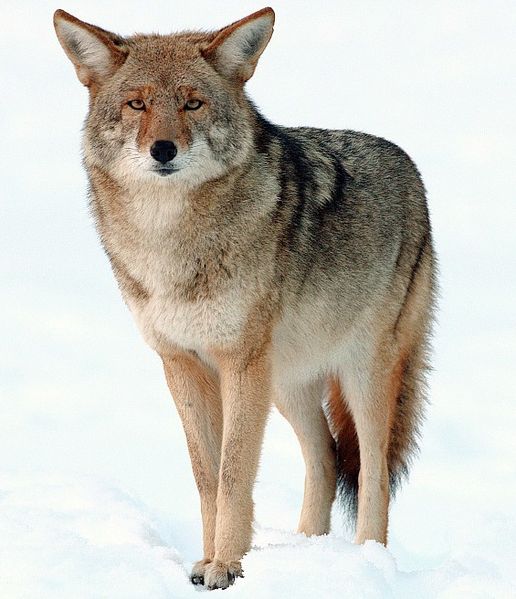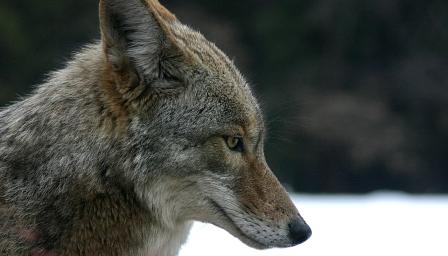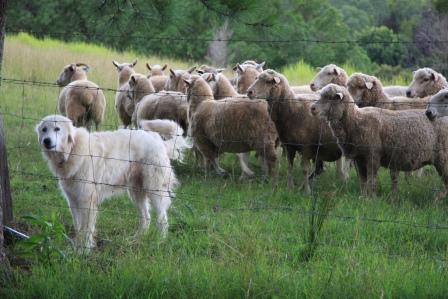
Cassandra Robertson was looking for her missing cat when she found the first victim. Before dying, the coyote had chewed off some of its leg. Her shock turned to disgust when she found a live raccoon in another trap.
Asking around, she discovered that Oregon State University’s Sheep Center, her neighbor in the hills outside of Corvallis, was using the infamous federal agency Wildlife Services (WS) to trap and poison coyotes. She protested; the traps were removed.
Victory was short lived. A year later the traps returned. She called OSU and was told that after the Sheep Center stopped using traps, they lost 100 of their 200 sheep to coyotes. The traps, she was told, would stay.
Robertson contacted Brooks Fahy of Predator Defense. He listened and advised. She formed a team that met with the Dean of the College of Agriculture and en-couraged him to make OSU a national leader in using nonlethal deterrents. Weeks passed with no response.
The group organized an evening of films and speakers. Around sixty people watched “Wild Things”, about learning to coexist with coyotes and “Exposed”, about the atrocities committed using taxpayers’ money and the out-of-control Wildlife Services.
Fahy spoke and his message was simple: He’s watched Wildlife Services for more than thirty years, and it can’t be reformed. It must be abolished. He added that the agency kills about 100,000 predators each year nationwide. Some are shot from an airplane as they run terrified. Others are trapped and left for days—or weeks—before the trapper returns. Some die when a device shoots a cyanide mist into the animal’s mouth after it pulls at bait. When Fahy factors in the pups that die after their parents are killed, he figures that WS causes the death of up to 500,000 predators every year.
 John Neumeister, a local sheep rancher and OSU graduate, told the audience that thirty years ago he bought his ranch near Corvallis. On one of his first nights there, he stood where his sheep would graze and heard coyote families singing from three different directions. What have I done? he wondered.
John Neumeister, a local sheep rancher and OSU graduate, told the audience that thirty years ago he bought his ranch near Corvallis. On one of his first nights there, he stood where his sheep would graze and heard coyote families singing from three different directions. What have I done? he wondered.
He remembered learning at OSU about guard dogs. He got his first—a pup that would grow to ninety pounds. Neumeister explained that coyotes are not stupid. They want an easy meal and his dogs intimidate. Over more than thirty years of grazing 60-100 sheep on his ranch annually, he has not lost one to coyotes. He thanks his dogs for that.
Neumeister can’t understand how OSU—a university that teaches livestock management—could lose 100 sheep a year to coyotes. He was asked how he would fix this problem at his alma mater. He pondered for a moment and then said that he would improve the fencing and use enough dogs to protect the herd.
That simple. And as it turns out, there are ranchers all across North America that agree.
In Ontario, Canada, Laurie Maus operates the 100-acre Hawk Hill Farm. In an essay on Coyote Watch Canada’s website, this rancher with a Master’s degree in biology wrote of how she looked at others who graze their livestock in coyote territory and then claim to have a coyote problem: “In truth, the coyotes have a human problem. Coyotes and humans want to use the same piece of property. It is up to us humans to figure out a way to coexist.”
Maus didn’t always feel that way. “Several years ago we started to raise sheep and my heart raced every time I heard a coyote sing. I heard many shepherds talk about their problems with coyotes, the kills and efforts to eradicate them. It sounded like an ever escalating arms war with no end in sight.”
She instituted nonlethal measures to protect her flock: using three guard dogs, building coyote-proof fencing, removing dead livestock and placentas, and installing strobe lights. (She’s not certain that the lights worked well.)
 She also made sure the coyotes had an alternative food source by leaving wild areas on the farm. This provides habitat for the rodents, raccoons, and skunks that coyotes eat. “Coyotes are not stupid. They will not risk their life to get something to eat if there is something available that does not pose a risk.”
She also made sure the coyotes had an alternative food source by leaving wild areas on the farm. This provides habitat for the rodents, raccoons, and skunks that coyotes eat. “Coyotes are not stupid. They will not risk their life to get something to eat if there is something available that does not pose a risk.”
Keli Hendricks and her husband operate the Bar C R Ranch in Petaluma, California. She wrote in Agweek about how they “…run 300 mother cows that calve in pastures alongside coyote packs and other predators.” They only use nonlethals and she can’t recall losing a calf to predators.
Hendricks adds that killing coyotes—while making ranchers feel that they are doing something to protect livestock—is counterproductive: “Coyotes biologically respond to hunting pressures by having more pack members breed, and in turn have larger litters in which more pups survive.” Additionally, “…packs that are fractured by hunting also leave juvenile coyotes orphaned, and thus more likely to come into conflict with pets and livestock.” And finally, killing coyotes “…creates a vacuum in which the newly opened territory eventually draws coyotes in to fill it.” Thus, killing coyotes “…creates the endless war between wildlife and ranchers that has been waging for decades at untold cost to taxpayers, ranchers, wildlife and the environment.”
Ranchers who have ended the war—stopped killing coyotes—find other benefits, according to Geri Vistein, a conservation biologist in Maine, who educates communities about coexisting with carnivores. She has travelled to a number of farms and found that “…those who are coexisting well with coyotes are successful farmers, and they are happy doing what they do!”
Officials at Oregon State University have not yet decided whether they want to co-exist with or kill coyotes. The local advocacy group has consulted with coyote experts around the country and is preparing a nonlethal deterrence plan that OSU could adopt. It’s ironic that a group composed of citizens is preparing a plan for a university filled with scientist and wildlife experts. Be that as it may, once the plan is submitted, it will be time for OSU to make a decision. I will follow up on this struggle and keep you advised.
 Rick Lamplugh is the author of the new bestselling book, In the Temple of Wolves: A Winter’s Immersion in Wild Yellowstone, which can be found on Amazon at http://amzn.to/Jpea9Q.
Rick Lamplugh is the author of the new bestselling book, In the Temple of Wolves: A Winter’s Immersion in Wild Yellowstone, which can be found on Amazon at http://amzn.to/Jpea9Q.
Guard dog & sheep by Andy Fitzimon
Coyote headshot by Christopher Bruno
 '
'
